ECO mode Alfa Romeo 147 2005 Owner handbook (in English)
[x] Cancel search | Manufacturer: ALFA ROMEO, Model Year: 2005, Model line: 147, Model: Alfa Romeo 147 2005Pages: 291, PDF Size: 5.52 MB
Page 118 of 291
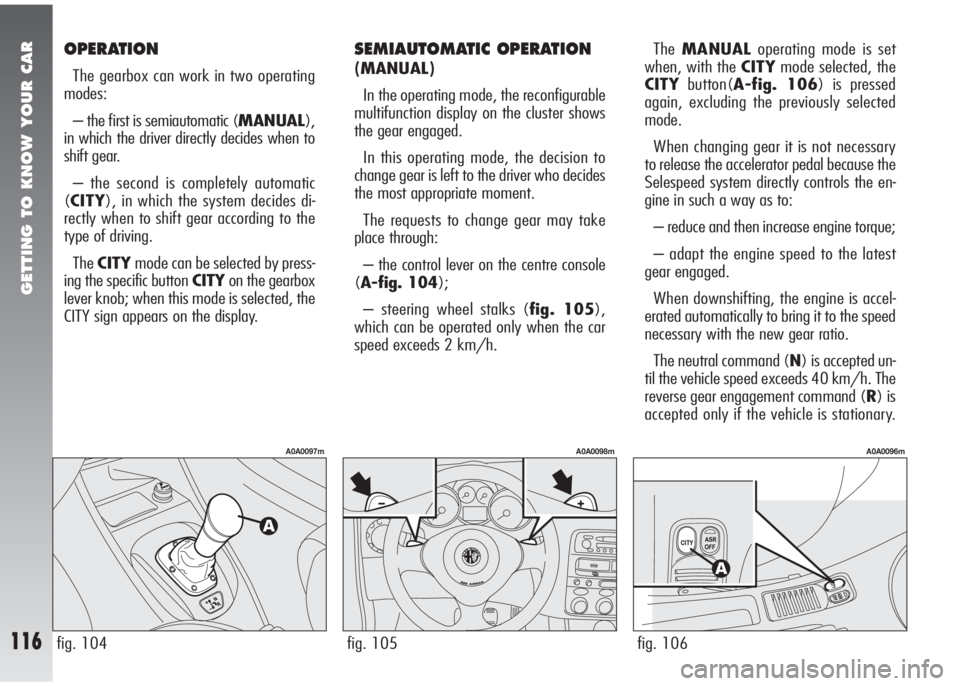
GETTING TO KNOW YOUR CAR
116fig. 105
A0A0098m
fig. 104
A0A0097m
fig. 106
A0A0096m
OPERATION
The gearbox can work in two operating
modes:
– the first is semiautomatic (MANUAL),
in which the driver directly decides when to
shift gear.
– the second is completely automatic
(CITY), in which the system decides di-
rectly when to shift gear according to the
type of driving.
TheCITYmode can be selected by press-
ing the specific button CITYon the gearbox
lever knob; when this mode is selected, the
CITY sign appears on the display.
SEMIAUTOMATIC OPERATION
(MANUAL)
In the operating mode, the reconfigurable
multifunction display on the cluster shows
the gear engaged.
In this operating mode, the decision to
change gear is left to the driver who decides
the most appropriate moment.
The requests to change gear may take
place through:
– the control lever on the centre console
(A-fig. 104);
– steering wheel stalks (fig. 105),
which can be operated only when the car
speed exceeds 2 km/h.TheMANUALoperating mode is set
when, with the CITYmode selected, the
CITYbutton(A-fig. 106) is pressed
again, excluding the previously selected
mode.
When changing gear it is not necessary
to release the accelerator pedal because the
Selespeed system directly controls the en-
gine in such a way as to:
– reduce and then increase engine torque;
– adapt the engine speed to the latest
gear engaged.
When downshifting, the engine is accel-
erated automatically to bring it to the speed
necessary with the new gear ratio.
The neutral command (N) is accepted un-
til the vehicle speed exceeds 40 km/h. The
reverse gear engagement command (R) is
accepted only if the vehicle is stationary.
Page 119 of 291

GETTING TO KNOW YOUR CAR
117
In the “MANUAL” operating mode there
are certain automatic/security devices which
simplify driving:
– when slowing down the clutch is opened
and the transmission ratio is automatically
reduced to be ready for picking up again;
otherwise, when the car is stopped, the
gearbox will automatically be in firstgear
(1);
– requests to change gear that would take
the engine to above maximum speed or be-
low minimum speed are not accepted;
– if jamming occurs during gear engage-
ment, the system firstly tries to engage the
gear required again and, if it is still not pos-
sible, it automatically engages the imme-
diately higher one to avoid leaving the car
inneutral.
IMPORTANTIt is advisable to wait for
the end of a gear shifting operation before
requesting another one, to avoid multiple
requests in rapid succession.AUTOMATIC OPERATION (CITY)
The automatic operating mode CITYis se-
lected pressing button (A-fig. 106) at the
base of the gearshift lever.
In addition to the gear, the reconfigurable
multifunction display shows the word CITY
(fig. 99).
The system decides directly when gearshift-
ing according to the engine running speed
and the driving style.
Releasing the accelerator pedal quickly, the
system does not engage a higher gear in or-
der to maintain an adequate level of engine
brake.
FAILURE WARNING
Failures of the Selespeed gearbox are shown
by the
twarning light (fig. 100) con-
nected with the associated failure message,
both shown on the display.
When the system is turned on (turning the
ignition key to MAR), the warning light
should turn on glowing steadily for about
4 seconds and then turn off.If the warning light stays on it means that
a fault to the gearbox has been detected; at
the same time a buzzer sounds intermit-
tently for 4 seconds to attract the driver's
attention.
In the case of a fault to the gearshift con-
trol lever, the system automatically engages
the automatic operating mode CITYto
make it possible to reach the nearest Alfa
Romeo Authorised Service to have the fault
eliminated.
In the case of a fault to other gearbox com-
ponents, the system only allows the en-
gagement of certain gears: first gear (1),
second gear (2) and reverse (R).
If warning light tand
the message appear on the
display, contact Alfa Romeo Au-
thorised Services as soon as pos-
sible to have the fault eliminated.
WARNING
Page 147 of 291
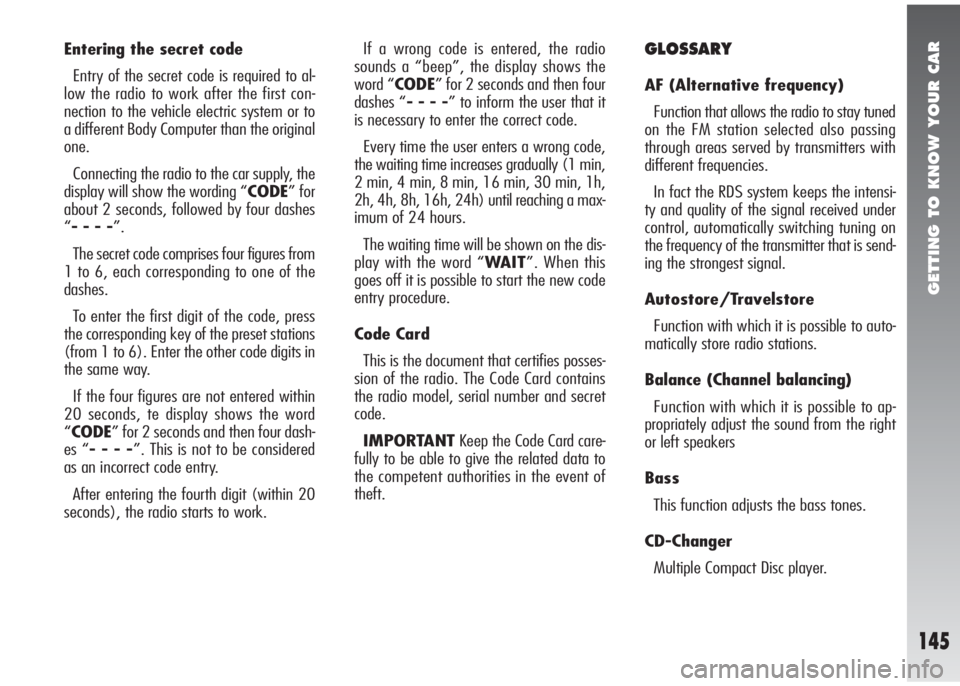
GETTING TO KNOW YOUR CAR
145
Entering the secret code
Entry of the secret code is required to al-
low the radio to work after the first con-
nection to the vehicle electric system or to
a different Body Computer than the original
one.
Connecting the radio to the car supply, the
display will show the wording “CODE” for
about 2 seconds, followed by four dashes
“- - - -”.
The secret code comprises four figures from
1 to 6, each corresponding to one of the
dashes.
To enter the first digit of the code, press
the corresponding key of the preset stations
(from 1 to 6). Enter the other code digits in
the same way.
If the four figures are not entered within
20 seconds, te display shows the word
“CODE” for 2 seconds and then four dash-
es “- - - -”. This is not to be considered
as an incorrect code entry.
After entering the fourth digit (within 20
seconds), the radio starts to work.If a wrong code is entered, the radio
sounds a “beep”, the display shows the
word “CODE” for 2 seconds and then four
dashes “- - - -” to inform the user that it
is necessary to enter the correct code.
Every time the user enters a wrong code,
the waiting time increases gradually (1 min,
2 min, 4 min, 8 min, 16 min, 30 min, 1h,
2h, 4h, 8h, 16h, 24h) until reaching a max-
imum of 24 hours.
The waiting time will be shown on the dis-
play with the word “WAIT”. When this
goes off it is possible to start the new code
entry procedure.
Code Card
This is the document that certifies posses-
sion of the radio. The Code Card contains
the radio model, serial number and secret
code.
IMPORTANTKeep the Code Card care-
fully to be able to give the related data to
the competent authorities in the event of
theft.GLOSSARY
AF (Alternative frequency)
Function that allows the radio to stay tuned
on the FM station selected also passing
through areas served by transmitters with
different frequencies.
In fact the RDS system keeps the intensi-
ty and quality of the signal received under
control, automatically switching tuning on
the frequency of the transmitter that is send-
ing the strongest signal.
Autostore/Travelstore
Function with which it is possible to auto-
matically store radio stations.
Balance (Channel balancing)
Function with which it is possible to ap-
propriately adjust the sound from the right
or left speakers
Bass
This function adjusts the bass tones.
CD-Changer
Multiple Compact Disc player.
Page 153 of 291

GETTING TO KNOW YOUR CAR
151
The functions that cannot be selected (e.g.
“CD” when the Compact Disc is not insert-
ed) are disabled automatically. If the Com-
pact Disc is not inserted and the CD-Chang-
er is not connected, pressing the “SRC” but-
ton (14) for about 2.5 seconds the display
will show only “NO CD”.
IMPORTANTWhen listening to the ra-
dio with a Compact Disc inserted and the
CD-Changer connected, pressing the “SRC”
button (14) will select the last function used
between Compact Disc and CD-Changer.
Pause function
If while listening to a Compact Disc another
function is selected (e.g. the radio), playing
is stopped and when the Compact Disc mode
is resumed. it starts again from the point
in which it was stopped.
If while listening to the radio another func-
tion is selected, when the Radio mode is
resumed, it is tuned to the last station se-
lected.Volume adjustment
Press button “VOL+” (21) to higher the
volume or “VOL-” (19) to lower it.
Pressing the button briefly the change is
gradual by steps. Pressing longer, the
change is fast. For a few seconds the dis-
play shows the wording “VOL” and the vol-
ume level (from 0 to 66).
If the volume level is changed during the
broadcast of a traffic bulletin or during use
of the phone (if the voice feature is in-
stalled), the new setting is maintained on-
ly until the end of the bulletin or phone call.
Volume changing with speed
The SVC function makes it possible to au-
tomatically adapt the volume level to the
speed of the car, increasing it as the speed
increases to maintain the ratio with the noise
level inside the passenger compartment.
To activate the SVC function briefly press
(less than 1 second) the “MENU” button
(9), then use buttons “
▲” (6) or “▼” (8)
to scroll the menu functions stopping on the
SVC function and buttons “
˙˙” (7) or
“
¯¯” (4) to turn the function on or off se-
lecting respectively “SVC ON” or “SVC
OFF”.
This function can be turned on or off in all
the operating modes of the device (Ra-
dio/Compact Disc/CD-Changer).Mute function (turning off the
volume completely)
To turn on the Mute function briefly press
(less than 1 second) the “
z” button (20).
The volume will lower gradually (Soft Mute
function) and the display will show
“MUTE”.
To turn the Mute function off, briefly press
the “
z” button again (20). The volume
will increase gradually (Soft Mute function)
returning to the value set before using the
Mute function.
The Mute function is also turned off press-
ing one of the volume adjustment buttons
“VOL+” (21) or “VOL-” (19): in this
case the volume is changed directly.
With the Mute function on, all the other
functions can be used and if a traffic bul-
letin arrives with the TA function on or an
emergency alarm is received, the message
ignores the Mute function.
Page 156 of 291
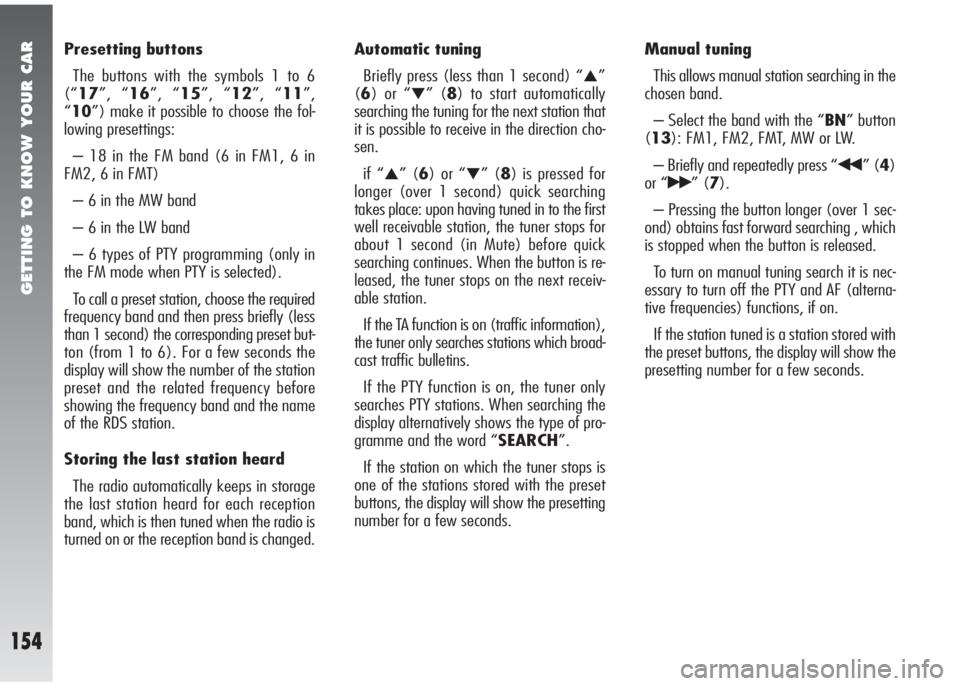
GETTING TO KNOW YOUR CAR
154
Presetting buttons
The buttons with the symbols 1 to 6
(“17”, “16”, “15”, “12”, “11”,
“10”) make it possible to choose the fol-
lowing presettings:
– 18 in the FM band (6 in FM1, 6 in
FM2, 6 in FMT)
– 6 in the MW band
– 6 in the LW band
– 6 types of PTY programming (only in
the FM mode when PTY is selected).
To call a preset station, choose the required
frequency band and then press briefly (less
than 1 second) the corresponding preset but-
ton (from 1 to 6). For a few seconds the
display will show the number of the station
preset and the related frequency before
showing the frequency band and the name
of the RDS station.
Storing the last station heard
The radio automatically keeps in storage
the last station heard for each reception
band, which is then tuned when the radio is
turned on or the reception band is changed.Automatic tuning
Briefly press (less than 1 second) “
▲”
(6) or “
▼” (8) to start automatically
searching the tuning for the next station that
it is possible to receive in the direction cho-
sen.
if “
▲” (6) or “▼” (8) is pressed for
longer (over 1 second) quick searching
takes place: upon having tuned in to the first
well receivable station, the tuner stops for
about 1 second (in Mute) before quick
searching continues. When the button is re-
leased, the tuner stops on the next receiv-
able station.
If the TA function is on (traffic information),
the tuner only searches stations which broad-
cast traffic bulletins.
If the PTY function is on, the tuner only
searches PTY stations. When searching the
display alternatively shows the type of pro-
gramme and the word “SEARCH”.
If the station on which the tuner stops is
one of the stations stored with the preset
buttons, the display will show the presetting
number for a few seconds.Manual tuning
This allows manual station searching in the
chosen band.
– Select the band with the “BN” button
(13): FM1, FM2, FMT, MW or LW.
– Briefly and repeatedly press “¯¯” (4)
or “
˙˙” (7).
– Pressing the button longer (over 1 sec-
ond) obtains fast forward searching , which
is stopped when the button is released.
To turn on manual tuning search it is nec-
essary to turn off the PTY and AF (alterna-
tive frequencies) functions, if on.
If the station tuned is a station stored with
the preset buttons, the display will show the
presetting number for a few seconds.
Page 159 of 291

GETTING TO KNOW YOUR CAR
157
The behaviour of the set during Autostore
is as follows:
– at the beginning of the Autostore func-
tion all the other functions are disabled
– any change in volume is not shown on
the display
– pressing one of the radio function but-
tons, for example “PTY” (2), “
˙˙” (7),
“
¯¯” (4), (17), (16), (15), (12),
(11), (10) the automatic storage process
is interrupted, the last station heard before
Autostore was turned on is tuned and the
function associated with the button pressed
is run
– pressing “AF-TA” (1) during auto-
matic storage will interrupt it, the TA func-
tion (traffic information) will be turned
on/off and a new automatic storage process
will be started
– Changing the sound source (Radio, Com-
pact Disc, CD-Changer) during automatic
storage, Autostore is not interrupted.
IMPORTANTSometimes the Autostore
function is unable to find 6 stations with a
strong signal. In this case, the free presetting
buttons will be shown on the display, for
about 2 seconds, by 4 dashes and the last
station heard will be returned.Listening to stored stations
Proceed as follows:
– select the required frequency band (FM,
MW, LW)
– briefly press one of the six station stor-
age buttons.
The display will show the number that cor-
responds to the button.
In bands FM1, FM2 and FMT, if reception
is poor and the AF alternative frequency
search function is active, the station with the
strongest signal that is broadcasting the
same programme will be sought automati-
cally. AF Function
(alternative frequency search)
Within the RDS system the radio can work
in two different modes:
AF ON: alternative frequency search on
AF OFF: alternative frequency search off.
When the signal of the RDS station tuned
weakens, the following two cases may oc-
cur:
– With AF ONthe RDS system activates
automatic tuning of the optimum frequency
of the station chosen, with the stations en-
abled, therefore the radio is automatically
tuned to the station with the strongest sig-
nal that is broadcasting the same pro-
gramme. During the journey it will thus be
possible to continue listening to the station
chosen without having to change the fre-
quency when changing area. Of course, the
station being listened to must be receivable
in the area the car is crossing.
– With AF OFFthe radio will not tune
the strongest station automatically and it
will have to be found manually using the
tuner buttons.
Page 162 of 291
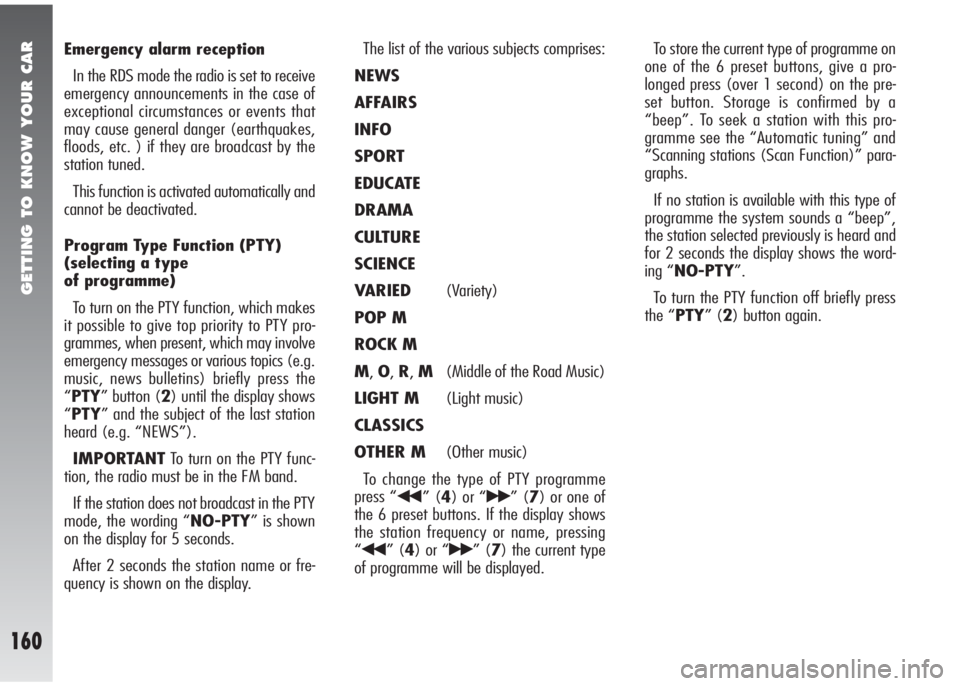
GETTING TO KNOW YOUR CAR
160
Emergency alarm reception
In the RDS mode the radio is set to receive
emergency announcements in the case of
exceptional circumstances or events that
may cause general danger (earthquakes,
floods, etc. ) if they are broadcast by the
station tuned.
This function is activated automatically and
cannot be deactivated.
Program Type Function (PTY)
(selecting a type
of programme)
To turn on the PTY function, which makes
it possible to give top priority to PTY pro-
grammes, when present, which may involve
emergency messages or various topics (e.g.
music, news bulletins) briefly press the
“PTY” button (2) until the display shows
“PTY” and the subject of the last station
heard (e.g. “NEWS”).
IMPORTANTTo turn on the PTY func-
tion, the radio must be in the FM band.
If the station does not broadcast in the PTY
mode, the wording “NO-PTY” is shown
on the display for 5 seconds.
After 2 seconds the station name or fre-
quency is shown on the display.The list of the various subjects comprises:
NEWS
AFFAIRS
INFO
SPORT
EDUCATE
DRAMA
CULTURE
SCIENCE
VARIED(Variety)
POP M
ROCK M
M,O,R,M(Middle of the Road Music)
LIGHT M(Light music)
CLASSICS
OTHER M(Other music)
To change the type of PTY programme
press “
¯¯” (4) or “˙˙” (7) or one of
the 6 preset buttons. If the display shows
the station frequency or name, pressing
“
¯¯” (4) or “˙˙” (7) the current type
of programme will be displayed.To store the current type of programme on
one of the 6 preset buttons, give a pro-
longed press (over 1 second) on the pre-
set button. Storage is confirmed by a
“beep”. To seek a station with this pro-
gramme see the “Automatic tuning” and
“Scanning stations (Scan Function)” para-
graphs.
If no station is available with this type of
programme the system sounds a “beep”,
the station selected previously is heard and
for 2 seconds the display shows the word-
ing “NO-PTY”.
To turn the PTY function off briefly press
the “PTY” (2) button again.
Page 167 of 291
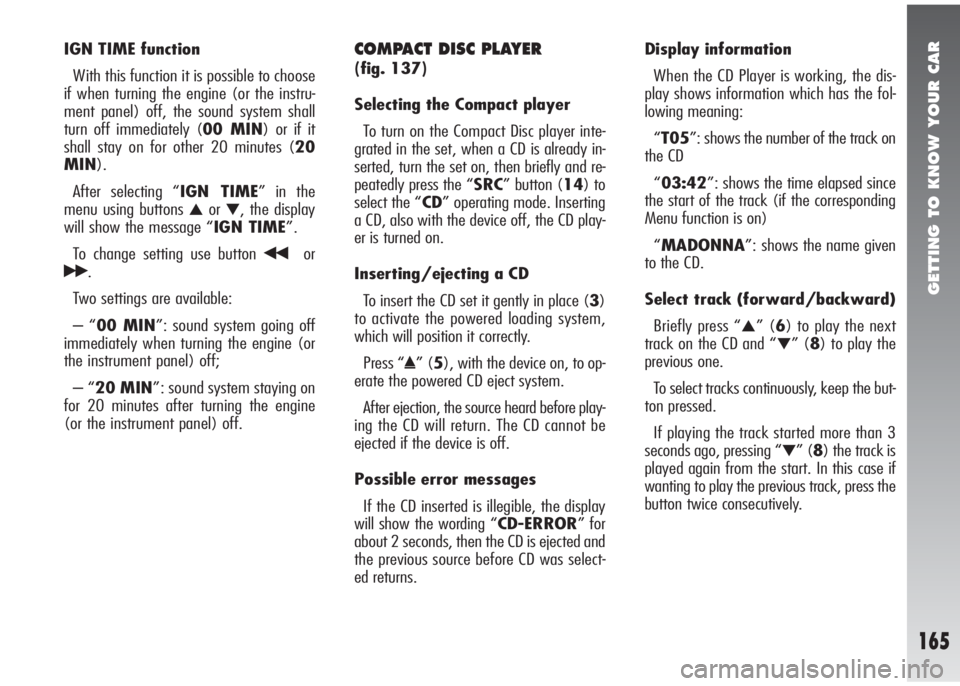
GETTING TO KNOW YOUR CAR
165
IGN TIME function
With this function it is possible to choose
if when turning the engine (or the instru-
ment panel) off, the sound system shall
turn off immediately (00 MIN) or if it
shall stay on for other 20 minutes (20
MIN).
After selecting “IGN TIME” in the
menu using buttons
▲or▼, the display
will show the message “IGN TIME”.
To change setting use button
¯¯or
˙˙.
Two settings are available:
– “00 MIN”: sound system going off
immediately when turning the engine (or
the instrument panel) off;
– “20 MIN”: sound system staying on
for 20 minutes after turning the engine
(or the instrument panel) off.
COMPACT DISC PLAYER
(fig. 137)
Selecting the Compact player
To turn on the Compact Disc player inte-
grated in the set, when a CD is already in-
serted, turn the set on, then briefly and re-
peatedly press the “SRC” button (14) to
select the “CD” operating mode. Inserting
a CD, also with the device off, the CD play-
er is turned on.
Inserting/ejecting a CD
To insert the CD set it gently in place (3)
to activate the powered loading system,
which will position it correctly.
Press “
˚” (5), with the device on, to op-
erate the powered CD eject system.
After ejection, the source heard before play-
ing the CD will return. The CD cannot be
ejected if the device is off.
Possible error messages
If the CD inserted is illegible, the display
will show the wording “CD-ERROR” for
about 2 seconds, then the CD is ejected and
the previous source before CD was select-
ed returns.Display information
When the CD Player is working, the dis-
play shows information which has the fol-
lowing meaning:
“T05”: shows the number of the track on
the CD
“03:42”: shows the time elapsed since
the start of the track (if the corresponding
Menu function is on)
“MADONNA”: shows the name given
to the CD.
Select track (forward/backward)
Briefly press “
▲” (6) to play the next
track on the CD and “
▼” (8) to play the
previous one.
To select tracks continuously, keep the but-
ton pressed.
If playing the track started more than 3
seconds ago, pressing “
▼” (8) the track is
played again from the start. In this case if
wanting to play the previous track, press the
button twice consecutively.
Page 188 of 291

CORRECT USE OF THE CAR
186
VEHICLE
INACTIVITY
If the vehicle is to be left inactive for long
periods, the following precautions should be
noted:
– House the vehicle under cover in a dry
and possibly ventilated place.
– Engage a gear.
– Check that the handbrake is not en-
gaged.
– Clean and protect the paintwork by pro-
tective wax.
– Cover the rubber windscreen and
rearscreen wiper blades with talcum powder
and raise them off the glass.
– Open the windows slightly.
– Inflate the tyres to a pressure of 0.5 bars
above normal. If possible rest the tyres on
wooden planks and periodically check the
pressure.
– Do not turn on the electronic alarm sys-
tem. Keep you speed
down when snow
chains are fitted.
Do not exceed 50 km/h. Avoid
potholes, steps and pavements to
prevent damaging the tyres, sus-
pension and steering.
Snow chains should only be applied to the
drive wheels (front).
Before purchasing or using snow chains,
you are recommended to contact Alfa
Romeo Authorised Services.
Check the tension of the chain after the
first few metres have been driven.SNOW CHAINS
Use of snow chains should be in compli-
ance with local regulations.
Use snow chains with reduced size with
maximum protrusion beyond the tyre pro-
file of 12 mm.
Snow chains may not be
used on tyres type 225/45
ZR 17”, 235/35 R18”.
Only spider type chains can be used
on tyres type 215/45 R17” and
215/45 ZR17”. SPIKES SPIDER
COMPACT snow chains (17003
compact model) with 9 arms and 16
mm adjustable length and 17"
wheel cover adapter are available
at Lineaccessori Alfa Romeo. Keep
your speed down when this type of
chains is fitted. Do not exceed 50
km/h with this type of chains,
avoid sudden acceleration and de-
activate the ASR system (the warn-
ing light on the button shall be on).
Remember that snow chains make
braking distance longer.
Page 266 of 291
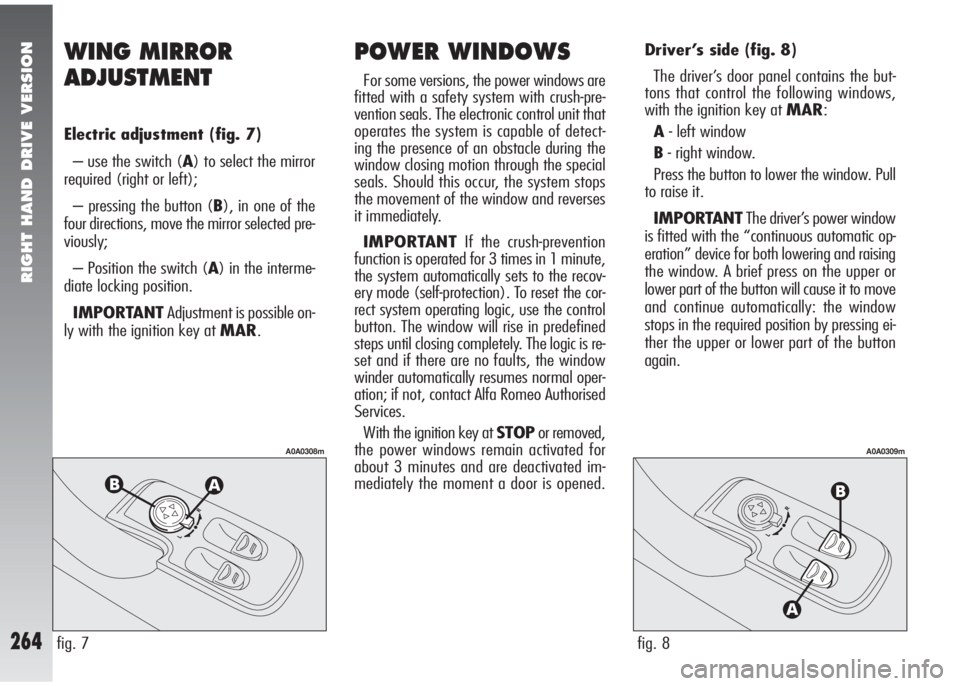
RIGHT HAND DRIVE VERSION
264
Driver’s side (fig. 8)
The driver’s door panel contains the but-
tons that control the following windows,
with the ignition key at MAR:
A- left window
B- right window.
Press the button to lower the window. Pull
to raise it.
IMPORTANTThe driver’s power window
is fitted with the “continuous automatic op-
eration” device for both lowering and raising
the window. A brief press on the upper or
lower part of the button will cause it to move
and continue automatically: the window
stops in the required position by pressing ei-
ther the upper or lower part of the button
again.
fig. 8
A0A0309m
WING MIRROR
ADJUSTMENT
Electric adjustment (fig. 7)
– use the switch (A) to select the mirror
required (right or left);
– pressing the button (B), in one of the
four directions, move the mirror selected pre-
viously;
– Position the switch (A) in the interme-
diate locking position.
IMPORTANTAdjustment is possible on-
ly with the ignition key at MAR.
fig. 7
A0A0308m
POWER WINDOWS
For some versions, the power windows are
fitted with a safety system with crush-pre-
vention seals. The electronic control unit that
operates the system is capable of detect-
ing the presence of an obstacle during the
window closing motion through the special
seals. Should this occur, the system stops
the movement of the window and reverses
it immediately.
IMPORTANTIf the crush-prevention
function is operated for 3 times in 1 minute,
the system automatically sets to the recov-
ery mode (self-protection). To reset the cor-
rect system operating logic, use the control
button. The window will rise in predefined
steps until closing completely. The logic is re-
set and if there are no faults, the window
winder automatically resumes normal oper-
ation; if not, contact Alfa Romeo Authorised
Services.
With the ignition key at STOPor removed,
the power windows remain activated for
about 3 minutes and are deactivated im-
mediately the moment a door is opened.